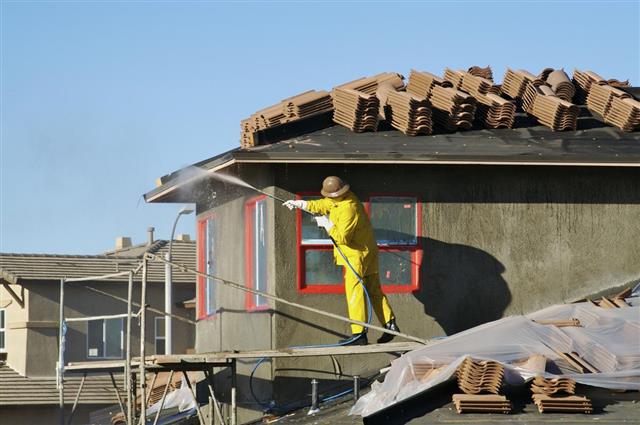
Stucco is one such building material which is well-known for its strength and durability. Cleaning it is important to keep its tidy look intact. In this article, we have discussed how to clean stucco.
Stucco is a siding material traditionally used on the exterior walls of the buildings that are made of concrete or brick. Traditional stucco material is composed of lime, sand and water. However, modern-day stucco consists of Portland cement, sand and water. It has excellent fireproof and waterproof qualities. It provides protection to the external surfaces from various weather elements. Basically, stucco does not require much maintenance. However, occasional cleaning is required to remove the mold, mildew, greasy stains or loosely bound dust particles that cling to its surface and make it unattractive. If you plan to paint stucco, then you also have to clean it thoroughly before that.
How to Clean Stucco Walls
While cleaning stucco walls, you have to use the right tools and techniques to avoid any kind of damage to the porous surface of the stucco. The main steps of stucco cleaning are as follows:
Make Proper Preparations
Cover up the plants and flower beds of the lawn with plastic sheets so that they do not get exposed to the harsh chemicals of the cleaner used for cleaning up the stucco walls. You have to set a ladder against the wall that can help you to reach out to the higher areas of the wall. Next, you have to protect yourself with adequate protective gear. Wear full sleeved clothes and hand gloves to protect your skin. Also wear goggles for protecting your eyes.
Procure the Cleaning Tools and Materials
The cleaning solution is prepared with trisodium phosphate or TSP, regular chlorine bleach and warm water. TSP is a commonly used household cleaning agent and can be safely used on stucco walls. It is found in powdered form and is available in local hardware stores. Take one gallon of warm water, add about half cup of bleach and one cup of trisodium phosphate (TSP) to it and mix them properly. Now, your cleaning solution is ready. You do not need any special tool for cleaning stucco. A soft bristled brush is enough to clean up the stucco without causing any damage to its surface.
Perform a Patch Test
Before you use the cleaning solution on the main area of the stucco, you must apply it on a small patch in some hidden location of the wall. Wait for some time to check if there is any change in the color of the stucco. If you notice any change in color, then you have to cut down on the amount of bleach used in it. You can add two more gallons of warm water into the solution that you have prepared in order to dilute the bleach.
Wet the Walls
You must divide the walls into small sections and clean one section at a time. This will help you to work more conveniently and effectively. Wet one small strip of the wall by spraying some water using a garden hose. You should always start applying the water to the bottom of the wall and move upwards. This way you can ensure that the dirty water that flows down from the upper walls does not get absorbed into the dry pores of the lower part of the stucco.
Clean the Stucco
Dip the scrub brush into the cleaning solution and scrub the stucco with it. Give special attention to the badly stained areas of the stucco. While scrubbing tough stains, make sure that you do not end up rubbing the brush too vigorously on stucco as it can cause extensive damage to it. Move the brush repeatedly but with a gentle hand. Once you have cleaned one section of the wall, rinse it off immediately to remove the dirt residue from it. If you allow the dirty water to settle on the stucco pores then you will leave behind some ugly stains on them. Follow the same procedure to clean up the remaining sections of the walls.
Finishing Touch
Once you have cleaned up the entire wall’s surface, rinse off all the walls thoroughly with plain water using the garden hose one more time. You may notice that a few spots may require a second round of scrubbing. Apply the cleaning solution on them one more time and wash off with water. Now, leave the stucco untouched till it dries up completely. After that, if you wish you can paint the surface.
It is true that this method of stucco cleaning involves a lot of hard work but you will feel immensely satisfied with the end results. You may feel that use of a pressure hawser is a more convenient option for you. However, the fact remains that the high pressure of water can be damaging for some delicate areas of stucco like areas around the windows, doors and corners of the walls.

